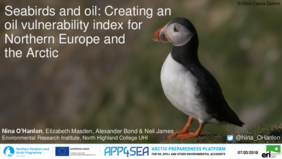Arctic coastal areas are a home for thousands of people, but also to many more scaled, feathered or furred animal species. The region is an important summer destination for many migratory seabirds as well as to species, who reside in the region more permanently and enjoy the open waters even in wintertime. However, as they are drawn to the sea, they are among the first ones in danger, if an oil spill happens in the Arctic waters and the oil spill response operations fail. What is the then the OVI factor, which can help us to estimate the potential impacts of oil on birds? Let the APP4SEA experts on seabirds, Nina O'Hanlon, Elizabeth Masden and Neil James from Environmental Research Institute at Thurso, Scotland, tell you more about the impacts of oil spills on birds:
"One of the aims of APP4SEA is to investigate the potential implications of oil spills on seabirds within the Arctic and Northern Periphery region. This involves identifying locations and species most at risk taking into account species vulnerability to oil spills, seabird spatial distributions, current and proposed protected areas and patterns of ship traffic and hydrocarbon extraction sites. One way in which this can be achieved is by calculating an index for sensitivity of seabirds to oil - Oil Vulnerability Index (OVI). In September we ran a workshop in Inverness inviting stakeholders from across the NPA region, representing both governmental and non-governmental organisations and research institutes. There was also excellent geographical representation with delegates having experience and expertise of seabirds and oil from Denmark, Falkland Islands, Greenland, Ireland, North American Arctic, Norway and the UK. During this workshop we discussed how to expand the current OVIs to the wider Northern Europe and the Arctic area, incorporating all seabird species that commonly occur within this region. The main challenges were how to overcome a lack of suitable data for determining the OVI factor values and for obtaining adequate spatial distribution / density data within the region of interest. We are now incorporating all the excellent comments from the workshop into a report to help us, and others, to assess seabird vulnerability to oil spills in large, and generally remote, areas such as the Arctic and Northern Periphery region."
If you want to learn more about the OVI or what kind of impacts oil can have on birds, have a look at Nina O'Hanlon's presentation, which she gave in Oulu during the Arctic Oil Spill conference in March 2018. The presentation is available below.

